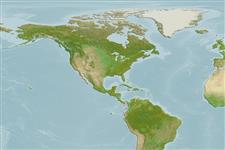Common names from other countries
Classification / Names
ชื่อสามัญ | ชื่อพ้อง | Catalog of Fishes(สกุล, ชนิด) | ITIS | CoL | WoRMS | Cloffa
sub class Elasmobranchii (ฉลามและกระเบน) (sharks and rays) >
Rajiformes (Skates and rays) >
Arhynchobatidae (Softnose skates)
Etymology: Notoraja: Greek, noton = back + Latin, raja = fish, Raja sp. (Ref. 45335); martinezi: Named for Jimmy Martínez, an Ecuadorian Biologist..
Environment: milieu / climate zone / depth range / distribution range
นิเวศวิทยา
เกี่ยวกับทะเล,น้ำเค็ม สัตว์หน้าดินในเขตน้ำลึก; ระดับความลึก 1256 - 1472 m (Ref. 117110). Deep-water
Eastern Pacific, between Costa Rica and Ecuador.
ขนาด / น้ำหนัก / Age
Maturity: Lm ? range ? - ? cm
Max length : 47.5 cm TL เพศผู้/กระเทย; (Ref. 117110); 34.6 cm TL (female)
Short description
เครื่องมือที่ใช้ในการแยกชนิดสัตว์,สิ่งมีชีวิตออกจากกัน | สัณฐานวิทยา | ความยาวต่างๆ
This heart-shaped, medium-size species is distinguished by the following characters: dark brownish dorsal and ventral surface; the disc is slightly wider 54.7 (51.7-55.2) %TL than long 51.6 (49.0-54.3) %TL; dorsal head length 21.3 (18.9-20.4) %TL; interspiracular width 6.3 (6.6-7.6) %TL; internarial space 8.4 (6.6-7.9) %TL; preorbital length 14.9 (13.0-14.9) %TL, 4.4 (3.8-4.9) times orbit length and 3.0 (2.9-3.3) times distance between eyes (interorbital space); tail width
at pelvic fin axil 1.5 (1.3-1.4) times its height; presence of a single, strong, hook-like, angled posteriorly preorbital thorn; disk with small, fine denticles, randomly distributed, slightly more abundant on the sides of the caudal region; long claspers (cloacal length) 23.8% TL and slim; long and slender tail, covered with abundant strong, thin, non aligned and posteriorly angled thorns, which differs from all other congeners; thin lateral tail folds merging at tail axil, thinner than tail width at any point and enlarged posteriorly; nasal lobes are expanded, nasal curtain maximum width 8.4 (7.8-9.5) %TL; anterior pelvic-fin lobe is longer than posterior 13.1 (16.2-16.8) %TL and 10.1 (7.8-9.8)% TL when straightened (shorter than posterior in natural position though); total pectoral-fin radials 65 (63-65); monospondylus centra 25 (24-26); predorsal diplospondylous centra 58 (60-65); total predorsal centra 83 (85-91); caudal centra 20 (22-25) total centra 118 (123-128) (Ref. 117110).
Female maturity and size at birth not known (but the smallest specimen taken was 24.3 cm TL) (Ref. 117110).
Life cycle and mating behavior
Maturities | การสืบพันธุ์ | Spawnings | Egg(s) | Fecundities | ตัวอ่อน
Concha, F.J., D.A. Ebert and D.J. Long, 2016. Notoraja martinezi sp. nov., a new species of deepwater skate and the first record of the genus Notoraja Ishiyama, 1958 (Rajiformes: Arhynchobatidae) from the eastern Pacific Ocean. Zootaxa 4098(1):179-190. (Ref. 117110)
IUCN Red List Status (Ref. 130435)
CITES (Ref. 128078)
Not Evaluated
Threat to humans
Harmless
Human uses
เครื่องมือ
Special reports
Download XML
แหล่งที่มาจากอินเตอร์เน็ต
Estimates based on models
Phylogenetic diversity index (Ref.
82804): PD
50 = 0.5001 [Uniqueness, from 0.5 = low to 2.0 = high].
Bayesian length-weight: a=0.01000 (0.00244 - 0.04107), b=3.04 (2.81 - 3.27), in cm Total Length, based on all LWR estimates for this body shape (Ref.
93245).
ระดับชั้นอาหาร (Ref.
69278): 3.8 ±0.7 se; based on size and trophs of closest relatives
ความสามารถในการกลับคืนสู่ปกติ (Ref.
120179): ขนาดกลาง, เวลาต่ำสุดที่จะทำให้ประชากรเพิ่มขึ้นเป็น 2 เท่าใช้เวลา 1.4 - 4.4 ปี (Preliminary K or Fecundity.).
Fishing Vulnerability (Ref.
59153): Moderate vulnerability (38 of 100).
